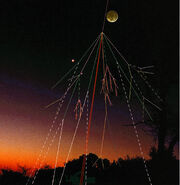
Cosmic Rays from outer space.
Cosmic rays are energetic particles originating from outer space that impinge on Earth's atmosphere. Almost 90% of all the incoming cosmic ray particles are simple protons, with nearly 10% being helium nuclei (alpha particles), and slightly under 1% are Periodic Table|heavier elements, electrons (beta particles), or gamma ray photons. The term ray is a misnomer, as cosmic particles arrive individually, not in the form of a ray or beam of particles. However, when they were first discovered, cosmic rays were thought to be rays. When their subatomic particle|particle nature needs to be emphasized, "cosmic ray particle" is written.
The variety of particle energies reflects the wide variety of sources. The origins of these particles range from energetic processes on the Sun all the way to as yet unknown events in the farthest reaches of the visible universe. Cosmic rays can have energies of over 1020 electron-volt (eV), far higher than the 1012 to 1013 eV that man-made particle accelerators can produce. (See Ultra-high-energy cosmic rays for a description of the detection of a single particle with an energy of about 50 Joule (J), the same as a well-hit tennis ball at 42 m/s [about 94 mph].) There has been interest in investigating cosmic rays of even greater energies.
Referred to by astrophysicist Rajesh Koothrappali.
